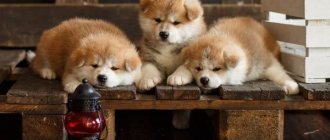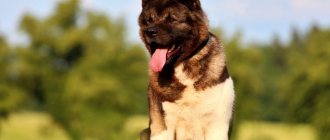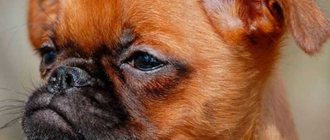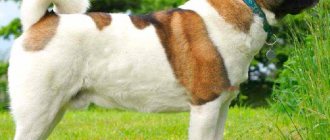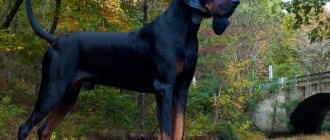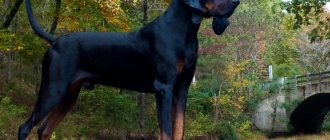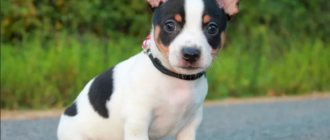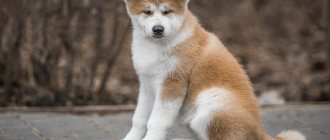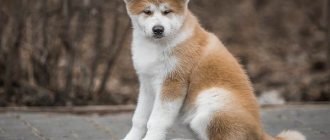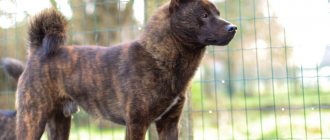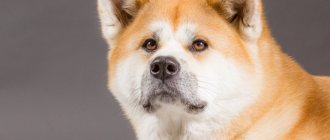There are not many recognized breeds from Japan in the world and almost all of them are passionately adored by their fans. Akita Inu is without a doubt the most famous representative of the four-legged world of Japan, if only because no other breed in the world has yet achieved fame of a similar scale. So, we are talking about the largest representative of the hunting and security four-legged animals of Japan, which has become the pride and national treasure of the homeland.
The Japanese Akita is quite strong in build, but it is so harmonious that each representative of the breed fits into strict geometric proportions. Courageous, decisive and noble temperament borders on loyalty, subtle intelligence and restraint.
This is interesting! In ancient times, representatives of the breed reflected the character of the samurai; they were trusted with the safety of the emperor and his property.
Historical reference
The Akita Inu dog breed is one of the earliest groups on the globe, this fact has been scientifically proven. Scientists were prompted to conduct DNA research by the skeletons of dogs that were buried 2 thousand years BC. e. During the study of ancient Japan, frescoes were discovered depicting large, fluffy dogs , most likely the ancestors of the Akita Inu familiar today. By the way, there is a version that the breed was obtained by mixing the blood of an ancient Japanese Spitz-type dog and Mastiffs.
This is interesting! From the time of its inception until almost the 40s of the 20th century, four-legged animals were actively used for hunting deer, elk, bear and other large game.
The name of the breed combines two terms: Inu - dog, Akita - the name of the territory (mountain province) on the island of Honshu. The dogs were bred for hunting and protection, and for a long time lived only in rural areas, so one of the central cities of Japan (obviously) cannot be the birthplace of the breed.
This is interesting! The first Akita Inu “breed clubs” (an organization in which people exchanged experience in breeding and training four-legged animals) were founded in the 11th century! Since the 15th century, Japan began to keep records of the development of the breed.
Officially, the history of the breed began in the 15th century , as evidenced by the investigations of scientists. Already by the 17th century, the impressive size and majestic disposition introduced the Akita Inu into the homes of the nobility and the palaces of rulers. It is noteworthy that the four-legged animals are purebred by nature; they were not bred or improved on purpose. Having started their journey from the houses of peasants, the tailed ones improved naturally.
By the 18th century, Akita Inu became the chosen ones, and only the nobility could own them. In Japan, a royal order of a national scale was announced on strict punishment or even execution of a person who dared to kill or simply offend a four-legged animal. The breed was concentrated in the hands of the great, each dog lived in abundance, and special attention was paid to its health and well-being. Only the Japanese Chins, the rights to which were also concentrated in the hands of the elite, received such honors. “Monopoly” had a positive effect on the purity of blood, but not on the “hardening” of the breed. By interfering with natural selection, people did dogs a disservice, although they only pursued good goals.
At the beginning of the 20th century, connoisseurs of the breed organized the first club that monitored the preservation of the purity of the blood of Japanese dogs (1919). By 1927, a highly specialized Akita Inu Club (AKIHO) was organized. A year later, another club caring for the breeds of Japan was organized in the capital - Nipponken Hozonkai (NIPPO).
With the outbreak of World War II, large dogs were needed at the fronts, where almost all Akita Inu were sent. The economic crisis had a negative impact on dog breeding and by the end of hostilities, old-fashioned purebred dogs could be counted on one hand.
This is interesting! During wartime, an order was issued calling all Akita Inu to the front. Some owners, risking their lives and freedom, hid their pets for more than 5 years. In fact, breaking the law made it possible to save the breed group from extinction.
The breed club got to work as soon as possible, and the Akita Inu was restored. It is difficult to say whether other breeds participated in breeding work, but if we think logically, it could not have happened without it. In the 19th century, European dogs began to be exported to Japan and, wanting to keep up with the needs, breeders began to breed new breeds, and this is how the Tosa Inu appeared. Akita Inu remained a “steadily developing” pure breed, although interbreed matings were no longer hidden.
Selection led to the emergence of three subspecies of the breed:
- Matagi-ken is the primary, indigenous type, which was used for hunting large animals.
- Fighting Akita - participated in exhibition fights.
- The Akita Shepherd is a service dog, a cross between an Akita Inu and a German Shepherd.
It is difficult to say whether breeding work has influenced the quality of the modern breed. Breeders who have dedicated their lives to breeding Akita Inu claim that the four-legged animals have become tougher and more aggressive towards the enemy. Externally, modern tailed animals look stronger and more muscular.
After the military conflict, American military bases were based on Japanese territory. When leaving home, soldiers often took puppies of local breeds with them. Conquered American breeders bred a larger version of the breed and called it the Great Japanese Dog, in the standard - American Akita.
The presence of a second, similar breed led to the need for an official “division” of dogs into groups. The American Kennel Club (AKC) recognized the Akita back in 1973 and published an official breed standard. Experts deliberately “omitted” the ancestors of four-legged animals from attention, that is, they did not recognize the Japanese Akita Inu. In response, Japan stopped exporting its dogs to America. The conflict lasted until 1922 and when it came to international recognition, the Americans “relented.” As a result, two breeds were recognized: the Great Japanese Dog and the Akita Inu.
This is interesting! The Akita Inu is often described as a Japanese husky. It is worth understanding that such a “nickname” is nothing more than an associative folk name. The breed has never mixed with Laikas and has nothing in common with them. Kishu (Xiyu) is the second “Japanese husky”, this is also a Spitz-shaped hunting dog. And finally, not a single Laika from Japan has yet been recognized in the world.
Legendary Hachiko
Even the most courageous viewers could not hold back their tears while watching the film “Hachiko”. The story began in the 20s of the 20th century, when the Akita Inu puppy Hachiko (Hashiko) was born, who became Professor Ueno’s pet. When the four-legged dog was 18 months old, he already knew all the commands and walked his owner to the train every day. Ueno worked at the University of Tokyo and every day upon returning home, his faithful dog was already waiting for him on the platform.
Appearance
According to Japanese breeders, an adult Akita Inu should fit into a figure consisting of triangles. The first standard issued by AKIHO in 1938 has been revised twice, in 1955 and in 2005. Recent changes have excluded black and spotted dogs from breeding.
The FCI breed description was compiled in 2001, and was based on the description of the Japanese Kynological Federation (JKC), and not AKIHO. Considering that almost all breeders from Japan are members of AKIHO, there are differences in the appearance of truly purebred dogs and those recognized by the international standard. The most contrasting point concerns growth; according to AKIHO’s description, an adult male grows to 60.6 cm at the withers, and a female to 54.5 cm.
For international judging, the FCI standard is relevant and if you (in the company of a pet) are not going to conquer Japan, you should focus on it. Akita Inu is a large, strong, calm, loyal, noble dog with pronounced sexual characteristics. Against the background of external power, the quadruped is distinguished by agility, modesty and tact. By the appearance of a dog, you can immediately determine not only the gender, but also the approximate age. Height is indicated by the standard, weight is proportional, but does not go beyond:
- Male : 64–70 cm; 45–59 kg.
- Female : 58–64 cm; 32–45 kg.
Breed standard
- The head is strictly proportional, all parts of the skull and muzzle must be combined and harmonized. The forehead is free from folds, rather wide, moderately high and flat, the transition to the muzzle is pronounced, the outlines of the transition are emphasized by the dividing groove. The ratio of the length of the muzzle to the length of the frontal part is 4:6. The line of the back of the nose and forehead is strictly parallel. The facial part is wide at the base, slightly tapering towards the nose, but never pointed. When viewed from the front, the muzzle should have a rounded silhouette , emphasized by “lush” cheeks. The lips are thick, strictly tailored to the silhouette of the head.
- The teeth are in the correct bite , strong, white.
- The nose is strictly proportional in size and almost square in shape, black in color. In dogs with white and clearly bleached coats, light brown or pink pigmentation of the nose is allowed, but black is always preferable.
- The eyes are almond-shaped with raised outer corners. When viewed from the front, the eyes appear almost triangular. Standing at medium height and width, slightly recessed. The eyelids are tight-fitting and dark brown . The color of the irises is dark, but harmonizes with the color of the coat. The expression of the gaze is majestic and calm, not stern or confused.
- Ears – set at medium height, with a slight slope towards the muzzle, thick, hard, triangular . When viewed from the side, an imaginary perpendicular drawn from the rounded tip of the ear should pass through the middle of a line at the base of the cartilage. Also, when viewed from the side, the outer inclined line of the ear is parallel to the axis of the neck. The ears should not droop to the sides or appear spread out.
- Body - the height of a male in relation to body length is in the proportion of 10:11 , females can be more elongated. The general silhouette, which fits into a square, is considered a disadvantage, since with “such” a body the dog loses its working characteristics. The neck is set at 45° to the horizontal support, strong and muscular. The leather fits tightly and does not create folds (not to be confused with a wool collar). The back is straight, turning into a wide and powerful loin and sloping croup. The length of the back is 2/4 of the total length of the body, the loin and croup are 1/4 each. The chest is voluminous, deep (50% of height at the withers), with a pronounced keel. The belly line is well tucked.
- The limbs are muscular and well developed, with strong joints. The front legs are straight and parallel, heavy, rather thick. The shoulders are developed, at a natural angle (110°), the elbows fit tightly to the sternum, the pasterns are powerful, set at a slight angle. The hind legs are strong and strong with muscular thighs, strong stifles (set at 120°) and hocks. The hands are almost round, the fingers are arched and collected. The pads are fleshy, the claws are short and bent.
- The tail is thick, carried high on the back, wrapped in a ring . The tail can be wrapped in one or two rings, thrown to the right or left side. When extended, it reaches the hock joints. The base of the tail is in line with the central axis of the neck. An under-curled tail is allowed, but can be considered a fault; an under-curled tail is a defect.
Tips for choosing a puppy
Their popularity has brought Hachiko's descendants to the top of the list of desirable dogs, with many fans of Japanese breeds considering the prospect of buying a Shiba Inu or Akita Inu. The cost of a puppy will be high in any case, but it is unreasonable to consider these dogs as analogues.
The differences between Akita Inu and Shiba Inu are size; the first is the largest, and the second is the smallest representative of Japanese hunting dogs. The character also differs, the Shiba is a hunter, and the Akita is a hunter and a serious guard. To put it mildly, if you compare the Akita Inu with the Shiba, then you can take into account all similar breeds - Kisu, Hokkaido, Shikoku, Kai-ken. All Japanese breeds are similar in appearance, but they were bred for different jobs.
When choosing a puppy, you need to take into account the characteristics of the breed, that is, the potential character of the dog with which you will live for 10–15 years. Not every owner is ready and able to devote 6-8 hours a day to walking, and this is required, for example, by the Belgian Shepherd; also, not all potential owners have experience in training “difficult” dogs. Characteristics of the Akita Inu breed will be given below, but it is relevant only for purebred dogs obtained from planned matings thought out from a genetic point of view.
Successful selection of a puppy comes down to the owner's intuitive decision and finding a breeder who will be honest and interested in the well-being of the “graduate”. Here are a few “guidelines” that will help you choose a nursery or breeder:
- Request documents (pedigrees) of the puppies' parents and information about past matings. A bitch is bred no more than once a year.
- Check the information provided and the reputation of the kennel by contacting the kennel club.
- Ask to visit and show all unsold puppies from the litter. You must also have access to personal acquaintance with the parents; if the dog is imported, the breeder must have all the data and documents.
- A breeder who has nothing to hide will, without resistance, provide contact information for people who bought puppies from previous litters.
- A caring “parent” not only offers, but also insists on constantly maintaining contact with the future owner (for consultations).
- Akita Inu puppies are offered for sale from the age of 3 months; if you are offered younger children, most likely you are negotiating with “businessmen”.
- Ask if there are (were there before) any defective puppies in the litter; if the answer is no, most likely you are being deceived.
- Breeders do not sell promising puppies (the most expensive ones) unless you intend to breed. Even if you need a breeding dog, say that you have not decided whether you will breed a ward, if you are still offered the “best” puppy - it means that we are talking about profit, and not about the well-being of the dog and its family.
What to do if you bought a mixed-breed German Shepherd
In any trading relationship there are unscrupulous sellers. Often, amateur breeders can pass off a crossbred puppy as a purebred one. They are similar when they are puppies. Only a specialist can accurately determine the purity of the breed.
With age, the differences become obvious. The pet is definitely a mixed breed. If a person absolutely wanted to have a purebred shepherd, you can contact the breeder with a claim. The second attempt needs to be planned more carefully. This option is suitable for those who planned to engage in purebred breeding.
If you were planning to have a pet, only the psychological compatibility of the owner (family members) and the dog matters. Mutual love and affection will appear long before the discrepancy between the breed is discovered.
Mixed breed pets
A dog is bought for a specific purpose, but we must remember that it is an animal. Her mental abilities should also be taken into account. In this context, crossbred individuals are especially versatile. Omissions in education can lead to dire consequences. Therefore, the decision to own a hybrid should be based on basic knowledge. Only then can you raise an adequate pet.
Character and training
The character of the Akita Inu is the same equivalent breed indicator as the ears, eyes and tail. The main feature that is emphasized in all standards is nobility. The self-sufficiency (but not arrogance) of dogs is visible in everything - appearance, stance, movements, behavior in society and at home. The Akita Inu is full of contradictions, which are combined and controlled at the discretion of the dog.
Important! Akita Inu is a brave, prudent and cold-blooded guard at work. You should not invite guests into your home while the puppy is adapting to its new home, but after that, do not forget about socialization within the protected area. The puppy must understand that not every person who enters the house is a potential threat.
Representatives of the breed are able to make lightning-fast decisions and also quickly implement them, but very rarely commit rash acts. This characteristic can be summarized by the term “balance.” Four-legged animals are very active, sometimes even cocky, but in the family and home they are quiet and almost unnoticeable. By the way, you can’t go too far either; Akita’s patience is not unlimited. Small children are quite persistent in their intentions and a four-legged animal can easily growl at a toddler.
Who are mestizos
Puppies obtained from crossing different breeds are called mixed breeds. It is believed that crossbred cubs are more resilient and strong. They have stronger immunity and are less aggressive.
Mixed dogs
Usually the process of mating of purebred animals is regulated by humans, and therefore the result is more predictable. Although it may result in a new breed with its own characteristics.
It is characteristic of mestizos that they are quite capable of reproduction. Mating is possible between the mestizos themselves and with representatives of other breeds.
For your information! The largest number of mestizos are produced by mongrels. There, even in a distant generation, it is not possible to find any specific breed.
Maintenance and care
As mentioned above, Akita Inu adapts well to being kept in an apartment. The rules of care do not depend on the method of keeping, but as practice shows, apartment pets are often bathed. You shouldn’t get carried away with bath procedures; the Akita Inu has a three-layer hard coat that repels dust naturally . If you are afraid of an odor, bathing will not improve the situation; it may even make it worse. Optimally, Akita Inu should be washed 2 times a year after shedding and complete combing.
Coat care is limited to brushing 1-2 times a week. The ears are examined for parasites (mites) and inflammatory processes (otitis media). Eye health is usually not a cause for concern, since four-legged animals very rarely suffer from conjunctivitis or similar ailments. However, the breed is prone to ophthalmological problems and needs regular examination by a veterinary ophthalmologist.
During preventive examinations, the veterinarian checks the condition of the dog's teeth . Plaque is removed by brushing; tartar requires intervention, but the removal procedure is not dangerous. The claws are trimmed with a guillotine nail clipper once every 2–3 weeks (or less often if they wear out naturally).
Important! There is no point in arguing about the importance of parasite prevention. Ticks or fleas that have settled in a pet's thick coat will be invisible until they cause harm. Do not forget about the mandatory treatment against blood-sucking parasites and worms, which is carried out all year round, regardless of the type of housing and nutrition.
Reviews
“I took a training course with our Akita. The training required a lot of attention and time, as well as an individual approach. Shepherd training methods did not suit her at all. Therefore, it is very important that the puppy is already well socialized before moving to the owner.”
Stanislav
“Our Akita is very kind and affectionate. She adores children and has been with them since birth. He never allows himself even an unkind glance towards the children. I’m proud of my loyal and smart dog, he’s the best breed!”
Katerina
“I’ve had a stunning American Akita living with me for a year now.
This dog, of course, needs care from the owner. Moreover, special attention must be paid to training, because a disobedient large dog can be dangerous to others. Therefore, the breed is ideal for strong and confident people who can gain authority from it.” Lyudmila Sergeevna
Feeding
On the Internet you can find slightly inadequate recommendations on how to feed the Akita Inu. For example, advice about a diet of rice and ocean fish or reducing the amount of meat. Perhaps some dogs suffering from pathologies or allergies really need such a specific diet, but certainly not all representatives of the breed.
The diet of Japanese dogs, like any other, must be balanced. Considering the size of an adult pet, it is necessary to strictly control the amount of vitamins and microelements in the diet. Traditionally, the owner has a choice between:
- Natural food - cereals and raw foods.
- Industrial food - dry food, semi-moist canned food or pates.
Both types have advantages and disadvantages. Natural food needs to be cooked, porridge must be fresh (that is, it needs to be cooked every day or every other day). For the “lazy”, there is a method for preparing homemade semi-finished products, then the preparation comes down to boiling the cereals and defrosting the remaining ingredients. As part of the standard ration, the dog should receive milk, raw fruits and vegetables, and vitamin supplements.
Industrial feed is more convenient, saving time and effort, but not money. Cheap food (economy) is not suitable for keeping Akita Inu, and super-premium and holistic class products will cost more than natural products. An undeniable advantage of the feed is that it contains vitamins and is easy to calculate the daily requirement. Akitas are dense and weighty by nature, their joints are constantly under heavy stress, and if the four-legged dog begins to gain weight, problems cannot be avoided. By the way, obesity can be a symptom of hormonal imbalance.
How to identify a purebred husky from a crossbreed
Since there are a huge number of husky mixes, and some puppies look very similar to purebred representatives of the breed, before buying you need to know what to look for so as not to make a mistake. After all, most mestizos are much cheaper.
Important! Mixed breeds can be either in one generation or transmitted from one generation to another.
First of all, you should pay attention to the cost of the puppy. Purebred huskies will cost much more. Some breeders may offer to pick up mixed breeds for free.
It is important to know what breed the cross was made with. This will help you understand how difficult raising a dog will be, as well as find out the characteristics of the pet’s character and health. However, unscrupulous breeders may try to pass off a fake as a purebred animal.
Only a genetic test will give you 100% confidence that the puppy you are buying is a husky. If it is not possible to conduct it, you should rely on the documentation provided by the kennel and the dog’s pedigree.
The baby's appearance is unlikely to help, since appearance is formed only in adolescence, not earlier than 12 months.
Signs by which you can determine whether a husky is purebred:
- these dogs do not bark, but howl, regardless of the emotions expressed (barking is generally unusual for them);
- Huskies are excellent nannies, not all mixed breeds retain this trait;
- Huskies will not make guards, while in mixed breeds with some large breeds this instinct is very well developed;
- these dogs do not have a specific odor, since their coat is capable of self-cleaning;
- strong limbs are a prerequisite for purebred dogs, since they are sled dogs;
- Eye color is only blue - there can be no exceptions.
If you want to buy a purebred dog, you need to choose only a proven kennel that has a good reputation. You should definitely ask questions to the breeder. If he cannot answer them or is in doubt, it is better to go elsewhere for the puppy.
Health
The average lifespan of an Akita Inu ranges from 11–15 years . Representatives of the breed have strong immunity, which is still not able to overcome deadly viral infections (distemper, enteritis, rabies, hepatitis, leptospirosis). A dog vaccinated on time is relatively protected, and with proper care, the risk of hereditary diseases is minimal.
The future owner should take into account that Akita Inu, like all large Spitz dogs, are prone to a number of age-related and acquired ailments:
- Hip dysplasia is an age-related disease that leads to deformation of the hip joints.
- Pseudoparalytic myasthenia gravis is an autoimmune disease affecting the muscular and musculoskeletal systems.
- Volvulus of the intestines or stomach is a deadly condition that can only be treated promptly.
- Von Willebrand disease is a disease of the hematopoietic system, similar to hemophilia, accompanied by unpredictable heavy bleeding from the mucous membranes.
- Ophthalmological diseases – progressive retinal atrophy, cataracts, entropy (entropion), glaucoma.
How much does a crossbreed cost?
Prices for husky mixes can vary greatly, depending on what breed they were crossed with:
- a purebred husky with a pedigree in kennels with a good reputation costs up to 60 thousand rubles;
- a mixture of Husky and Pomeranian Spitz is a designer breed, and therefore very expensive, its cost can exceed the cost of a purebred animal;
- A husky mixed with a malamute costs significantly less than the original - up to 5 thousand rubles.
Mixed breeds of many breeds are given for a symbolic price or absolutely free.
